Nursing Critical Reflection: Gibbs Cycle and Medication Error Analysis
VerifiedAdded on 2023/06/08
|7
|1628
|177
Essay
AI Summary
This essay critically reflects on a medication error case involving a patient, Ruth Stoll, who died after receiving the wrong blood transfusion due to mislabeled samples by a nurse at Clinpath Laboratories. The reflection uses Gibbs' Reflective Cycle to describe the incident, feelings, and evaluation, highlighting the nurse's negligence and lack of accountability as the primary cause. The analysis emphasizes the importance of adhering to national safety standards and the ethical principles of beneficence and non-maleficence in nursing practice. The discussion points out that medication errors are a significant challenge in healthcare, often resulting from negligence and lack of accountability. An action plan is proposed, focusing on learning effective documentation processes, establishing patient partnerships, and exploring relevant practice guidelines and safety frameworks. The reflection concludes with a commitment to vigilance and adherence to professional standards to prevent future medical errors, emphasizing the profound impact of nursing actions on patient outcomes. Desklib offers similar solved assignments for students.

Running head: NURSING CRITICAL REFLECTION
Nursing critical reflection
Name of the student:
Name of the university:
Author note:
Nursing critical reflection
Name of the student:
Name of the university:
Author note:
Paraphrase This Document
Need a fresh take? Get an instant paraphrase of this document with our AI Paraphraser
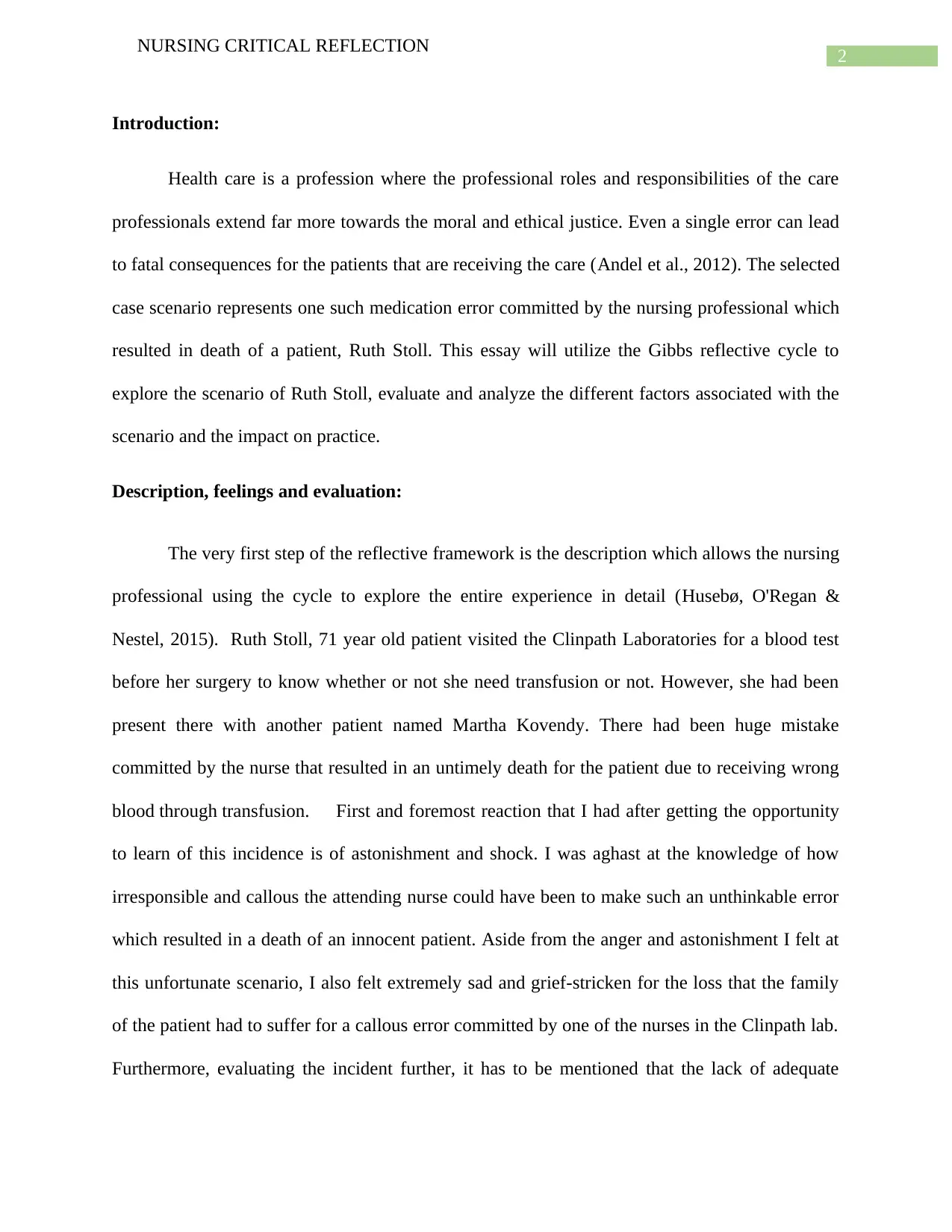
2
NURSING CRITICAL REFLECTION
Introduction:
Health care is a profession where the professional roles and responsibilities of the care
professionals extend far more towards the moral and ethical justice. Even a single error can lead
to fatal consequences for the patients that are receiving the care (Andel et al., 2012). The selected
case scenario represents one such medication error committed by the nursing professional which
resulted in death of a patient, Ruth Stoll. This essay will utilize the Gibbs reflective cycle to
explore the scenario of Ruth Stoll, evaluate and analyze the different factors associated with the
scenario and the impact on practice.
Description, feelings and evaluation:
The very first step of the reflective framework is the description which allows the nursing
professional using the cycle to explore the entire experience in detail (Husebø, O'Regan &
Nestel, 2015). Ruth Stoll, 71 year old patient visited the Clinpath Laboratories for a blood test
before her surgery to know whether or not she need transfusion or not. However, she had been
present there with another patient named Martha Kovendy. There had been huge mistake
committed by the nurse that resulted in an untimely death for the patient due to receiving wrong
blood through transfusion. First and foremost reaction that I had after getting the opportunity
to learn of this incidence is of astonishment and shock. I was aghast at the knowledge of how
irresponsible and callous the attending nurse could have been to make such an unthinkable error
which resulted in a death of an innocent patient. Aside from the anger and astonishment I felt at
this unfortunate scenario, I also felt extremely sad and grief-stricken for the loss that the family
of the patient had to suffer for a callous error committed by one of the nurses in the Clinpath lab.
Furthermore, evaluating the incident further, it has to be mentioned that the lack of adequate
NURSING CRITICAL REFLECTION
Introduction:
Health care is a profession where the professional roles and responsibilities of the care
professionals extend far more towards the moral and ethical justice. Even a single error can lead
to fatal consequences for the patients that are receiving the care (Andel et al., 2012). The selected
case scenario represents one such medication error committed by the nursing professional which
resulted in death of a patient, Ruth Stoll. This essay will utilize the Gibbs reflective cycle to
explore the scenario of Ruth Stoll, evaluate and analyze the different factors associated with the
scenario and the impact on practice.
Description, feelings and evaluation:
The very first step of the reflective framework is the description which allows the nursing
professional using the cycle to explore the entire experience in detail (Husebø, O'Regan &
Nestel, 2015). Ruth Stoll, 71 year old patient visited the Clinpath Laboratories for a blood test
before her surgery to know whether or not she need transfusion or not. However, she had been
present there with another patient named Martha Kovendy. There had been huge mistake
committed by the nurse that resulted in an untimely death for the patient due to receiving wrong
blood through transfusion. First and foremost reaction that I had after getting the opportunity
to learn of this incidence is of astonishment and shock. I was aghast at the knowledge of how
irresponsible and callous the attending nurse could have been to make such an unthinkable error
which resulted in a death of an innocent patient. Aside from the anger and astonishment I felt at
this unfortunate scenario, I also felt extremely sad and grief-stricken for the loss that the family
of the patient had to suffer for a callous error committed by one of the nurses in the Clinpath lab.
Furthermore, evaluating the incident further, it has to be mentioned that the lack of adequate
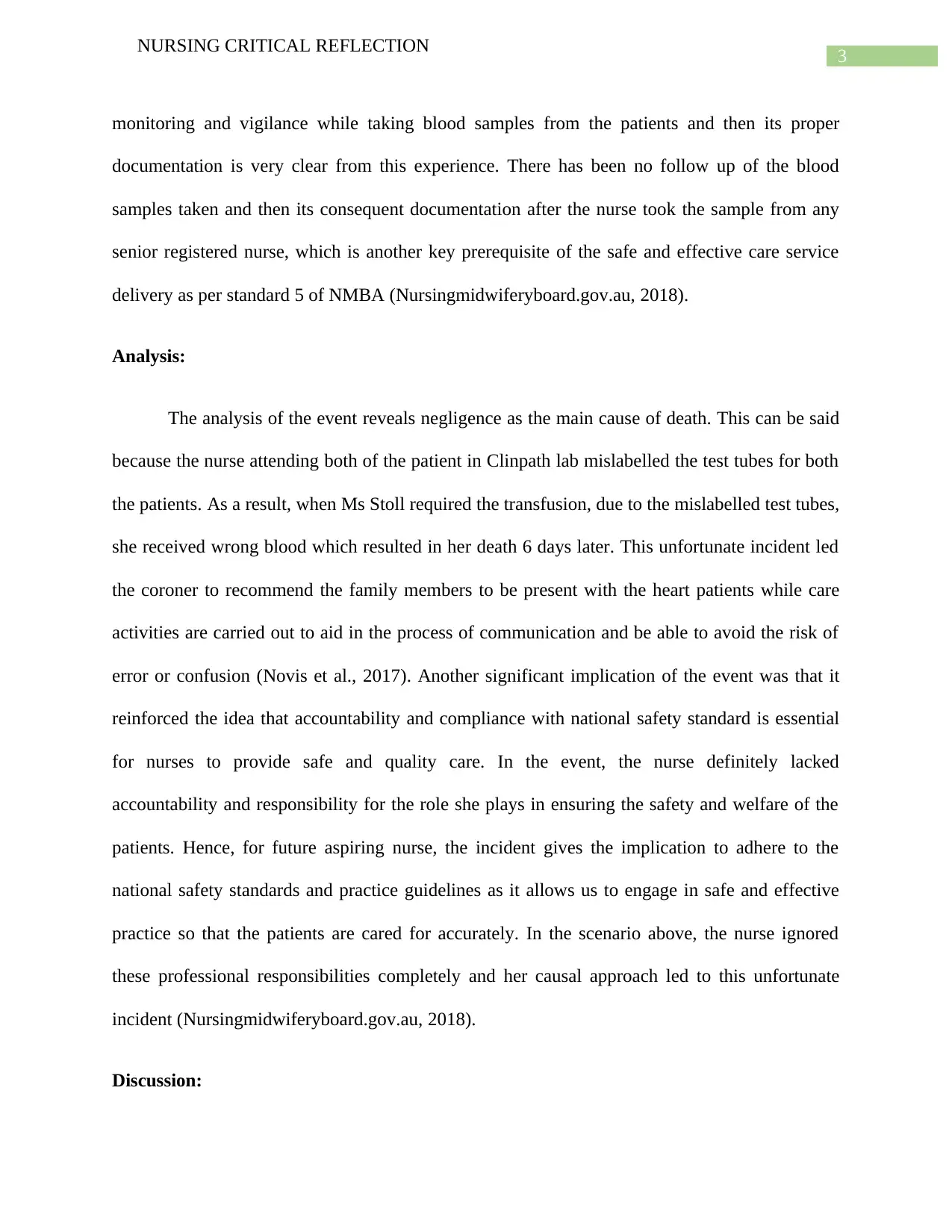
3
NURSING CRITICAL REFLECTION
monitoring and vigilance while taking blood samples from the patients and then its proper
documentation is very clear from this experience. There has been no follow up of the blood
samples taken and then its consequent documentation after the nurse took the sample from any
senior registered nurse, which is another key prerequisite of the safe and effective care service
delivery as per standard 5 of NMBA (Nursingmidwiferyboard.gov.au, 2018).
Analysis:
The analysis of the event reveals negligence as the main cause of death. This can be said
because the nurse attending both of the patient in Clinpath lab mislabelled the test tubes for both
the patients. As a result, when Ms Stoll required the transfusion, due to the mislabelled test tubes,
she received wrong blood which resulted in her death 6 days later. This unfortunate incident led
the coroner to recommend the family members to be present with the heart patients while care
activities are carried out to aid in the process of communication and be able to avoid the risk of
error or confusion (Novis et al., 2017). Another significant implication of the event was that it
reinforced the idea that accountability and compliance with national safety standard is essential
for nurses to provide safe and quality care. In the event, the nurse definitely lacked
accountability and responsibility for the role she plays in ensuring the safety and welfare of the
patients. Hence, for future aspiring nurse, the incident gives the implication to adhere to the
national safety standards and practice guidelines as it allows us to engage in safe and effective
practice so that the patients are cared for accurately. In the scenario above, the nurse ignored
these professional responsibilities completely and her causal approach led to this unfortunate
incident (Nursingmidwiferyboard.gov.au, 2018).
Discussion:
NURSING CRITICAL REFLECTION
monitoring and vigilance while taking blood samples from the patients and then its proper
documentation is very clear from this experience. There has been no follow up of the blood
samples taken and then its consequent documentation after the nurse took the sample from any
senior registered nurse, which is another key prerequisite of the safe and effective care service
delivery as per standard 5 of NMBA (Nursingmidwiferyboard.gov.au, 2018).
Analysis:
The analysis of the event reveals negligence as the main cause of death. This can be said
because the nurse attending both of the patient in Clinpath lab mislabelled the test tubes for both
the patients. As a result, when Ms Stoll required the transfusion, due to the mislabelled test tubes,
she received wrong blood which resulted in her death 6 days later. This unfortunate incident led
the coroner to recommend the family members to be present with the heart patients while care
activities are carried out to aid in the process of communication and be able to avoid the risk of
error or confusion (Novis et al., 2017). Another significant implication of the event was that it
reinforced the idea that accountability and compliance with national safety standard is essential
for nurses to provide safe and quality care. In the event, the nurse definitely lacked
accountability and responsibility for the role she plays in ensuring the safety and welfare of the
patients. Hence, for future aspiring nurse, the incident gives the implication to adhere to the
national safety standards and practice guidelines as it allows us to engage in safe and effective
practice so that the patients are cared for accurately. In the scenario above, the nurse ignored
these professional responsibilities completely and her causal approach led to this unfortunate
incident (Nursingmidwiferyboard.gov.au, 2018).
Discussion:
⊘ This is a preview!⊘
Do you want full access?
Subscribe today to unlock all pages.

Trusted by 1+ million students worldwide

4
NURSING CRITICAL REFLECTION
The above incidence gives an idea about the circumstances in which medication injuries
occur. Medication error is by far one of the greatest challenges to the progress of the health care
industry. Such errors are basically the result of extreme negligence and lack of accountability in
the health care workforce, for which the patents are bearing the cost with their lives. According
to the ethical principle of beneficence and non-maleficence, not engaging in any activity that can
cause direct harm to the patient, is one of the integral requirements expected from the health care
professionals (Scott, Anderson, Freeman & Stowasser, 2014). However, in this case, the lab
nurse in her negligence or hurry directly participated in an action which directly engaged in a
practice that not just caused harm, but resulted in the death of the patient. If any registered
nursing supervisor had been present in this scenario such an error could have been corrected and
the fatal consequences could have been easily avoided. If the family members were involved in
the process, the mislabelling could have been avoided (Wachter, Pronovost & Shekelle, 2013).
Hence, the incident gives the lesson that nursing values of accountability and adhering safety
standards is critical to avoid medication errors. It encourages nurse to take extra responsibility
while engaging in medication administration process.
Action plan:
The action plan is to analyse the cause of medication errors and learn strategies to
overcome them in practice. In this case, the care staff of the lab failed to carry out proper
identification and documentation while taking the blood sample. Hence, the action plan is to
learn about effective documentation process as proper identification of patient and
documentation procedure is a perquisite of the nursing standards of NMBA
(Nursingmidwiferyboard.gov.au, 2018). Another very important aspect of the care is the fact that
the nurse in question failed completely to establish partnership with the patients and her family
NURSING CRITICAL REFLECTION
The above incidence gives an idea about the circumstances in which medication injuries
occur. Medication error is by far one of the greatest challenges to the progress of the health care
industry. Such errors are basically the result of extreme negligence and lack of accountability in
the health care workforce, for which the patents are bearing the cost with their lives. According
to the ethical principle of beneficence and non-maleficence, not engaging in any activity that can
cause direct harm to the patient, is one of the integral requirements expected from the health care
professionals (Scott, Anderson, Freeman & Stowasser, 2014). However, in this case, the lab
nurse in her negligence or hurry directly participated in an action which directly engaged in a
practice that not just caused harm, but resulted in the death of the patient. If any registered
nursing supervisor had been present in this scenario such an error could have been corrected and
the fatal consequences could have been easily avoided. If the family members were involved in
the process, the mislabelling could have been avoided (Wachter, Pronovost & Shekelle, 2013).
Hence, the incident gives the lesson that nursing values of accountability and adhering safety
standards is critical to avoid medication errors. It encourages nurse to take extra responsibility
while engaging in medication administration process.
Action plan:
The action plan is to analyse the cause of medication errors and learn strategies to
overcome them in practice. In this case, the care staff of the lab failed to carry out proper
identification and documentation while taking the blood sample. Hence, the action plan is to
learn about effective documentation process as proper identification of patient and
documentation procedure is a perquisite of the nursing standards of NMBA
(Nursingmidwiferyboard.gov.au, 2018). Another very important aspect of the care is the fact that
the nurse in question failed completely to establish partnership with the patients and her family
Paraphrase This Document
Need a fresh take? Get an instant paraphrase of this document with our AI Paraphraser
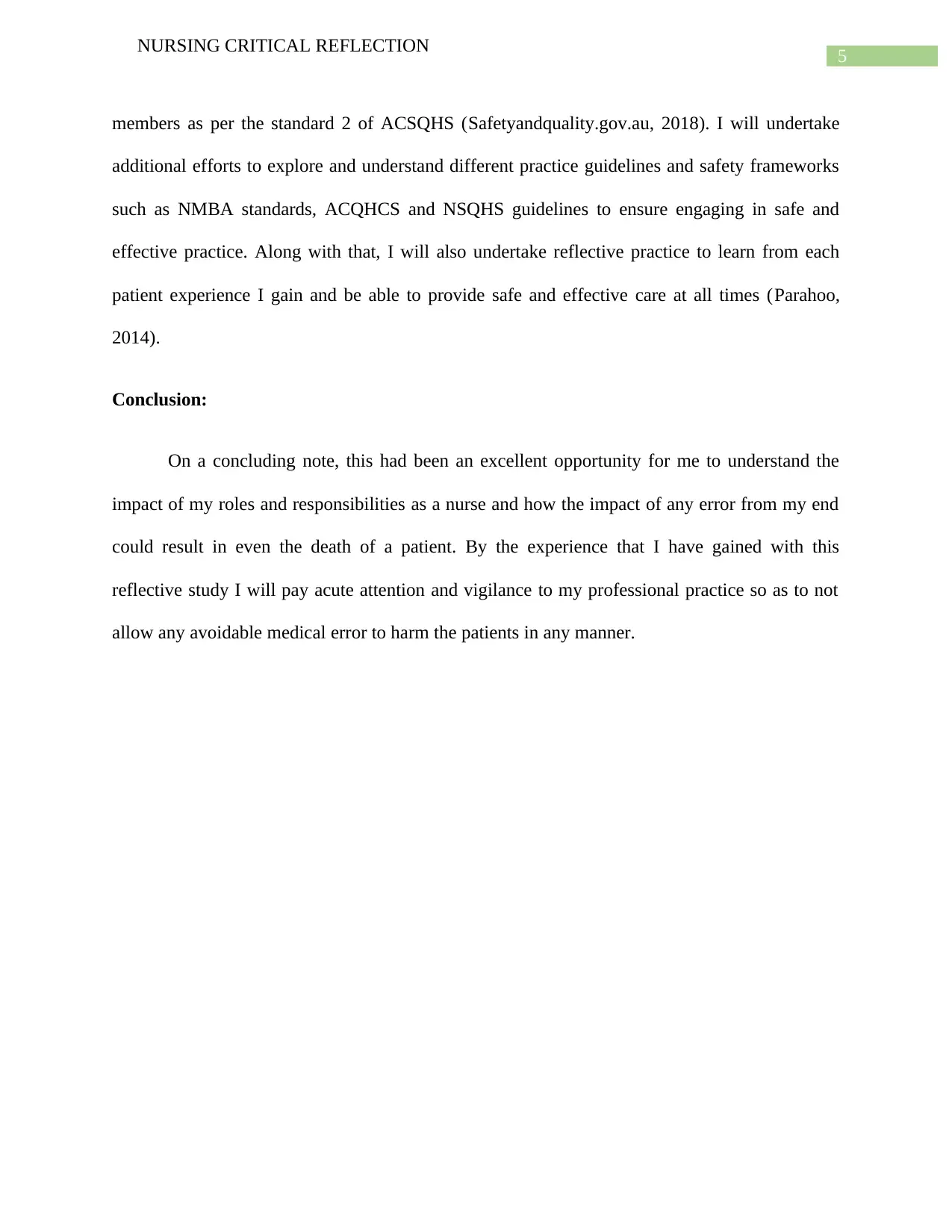
5
NURSING CRITICAL REFLECTION
members as per the standard 2 of ACSQHS (Safetyandquality.gov.au, 2018). I will undertake
additional efforts to explore and understand different practice guidelines and safety frameworks
such as NMBA standards, ACQHCS and NSQHS guidelines to ensure engaging in safe and
effective practice. Along with that, I will also undertake reflective practice to learn from each
patient experience I gain and be able to provide safe and effective care at all times (Parahoo,
2014).
Conclusion:
On a concluding note, this had been an excellent opportunity for me to understand the
impact of my roles and responsibilities as a nurse and how the impact of any error from my end
could result in even the death of a patient. By the experience that I have gained with this
reflective study I will pay acute attention and vigilance to my professional practice so as to not
allow any avoidable medical error to harm the patients in any manner.
NURSING CRITICAL REFLECTION
members as per the standard 2 of ACSQHS (Safetyandquality.gov.au, 2018). I will undertake
additional efforts to explore and understand different practice guidelines and safety frameworks
such as NMBA standards, ACQHCS and NSQHS guidelines to ensure engaging in safe and
effective practice. Along with that, I will also undertake reflective practice to learn from each
patient experience I gain and be able to provide safe and effective care at all times (Parahoo,
2014).
Conclusion:
On a concluding note, this had been an excellent opportunity for me to understand the
impact of my roles and responsibilities as a nurse and how the impact of any error from my end
could result in even the death of a patient. By the experience that I have gained with this
reflective study I will pay acute attention and vigilance to my professional practice so as to not
allow any avoidable medical error to harm the patients in any manner.
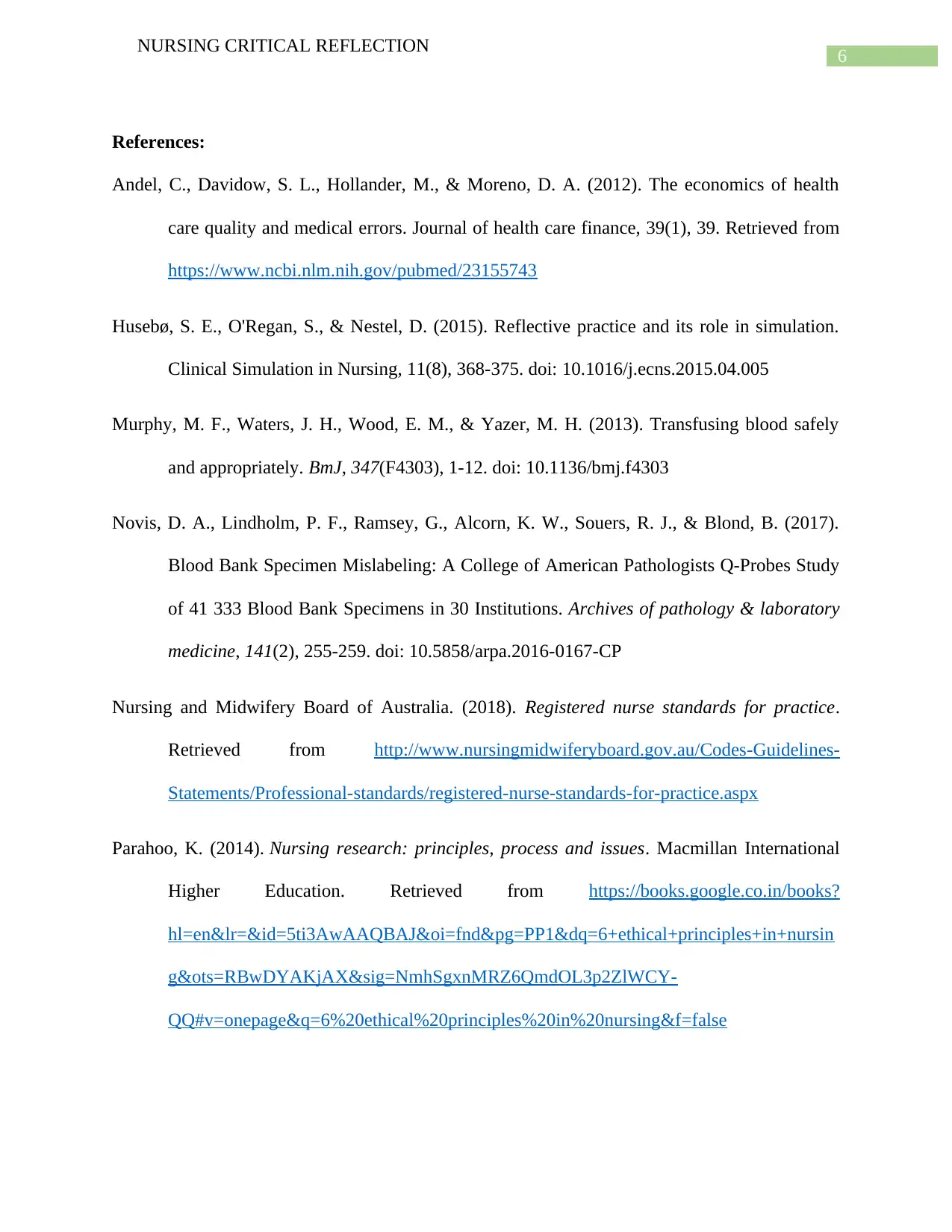
6
NURSING CRITICAL REFLECTION
References:
Andel, C., Davidow, S. L., Hollander, M., & Moreno, D. A. (2012). The economics of health
care quality and medical errors. Journal of health care finance, 39(1), 39. Retrieved from
https://www.ncbi.nlm.nih.gov/pubmed/23155743
Husebø, S. E., O'Regan, S., & Nestel, D. (2015). Reflective practice and its role in simulation.
Clinical Simulation in Nursing, 11(8), 368-375. doi: 10.1016/j.ecns.2015.04.005
Murphy, M. F., Waters, J. H., Wood, E. M., & Yazer, M. H. (2013). Transfusing blood safely
and appropriately. BmJ, 347(F4303), 1-12. doi: 10.1136/bmj.f4303
Novis, D. A., Lindholm, P. F., Ramsey, G., Alcorn, K. W., Souers, R. J., & Blond, B. (2017).
Blood Bank Specimen Mislabeling: A College of American Pathologists Q-Probes Study
of 41 333 Blood Bank Specimens in 30 Institutions. Archives of pathology & laboratory
medicine, 141(2), 255-259. doi: 10.5858/arpa.2016-0167-CP
Nursing and Midwifery Board of Australia. (2018). Registered nurse standards for practice.
Retrieved from http://www.nursingmidwiferyboard.gov.au/Codes-Guidelines-
Statements/Professional-standards/registered-nurse-standards-for-practice.aspx
Parahoo, K. (2014). Nursing research: principles, process and issues. Macmillan International
Higher Education. Retrieved from https://books.google.co.in/books?
hl=en&lr=&id=5ti3AwAAQBAJ&oi=fnd&pg=PP1&dq=6+ethical+principles+in+nursin
g&ots=RBwDYAKjAX&sig=NmhSgxnMRZ6QmdOL3p2ZlWCY-
QQ#v=onepage&q=6%20ethical%20principles%20in%20nursing&f=false
NURSING CRITICAL REFLECTION
References:
Andel, C., Davidow, S. L., Hollander, M., & Moreno, D. A. (2012). The economics of health
care quality and medical errors. Journal of health care finance, 39(1), 39. Retrieved from
https://www.ncbi.nlm.nih.gov/pubmed/23155743
Husebø, S. E., O'Regan, S., & Nestel, D. (2015). Reflective practice and its role in simulation.
Clinical Simulation in Nursing, 11(8), 368-375. doi: 10.1016/j.ecns.2015.04.005
Murphy, M. F., Waters, J. H., Wood, E. M., & Yazer, M. H. (2013). Transfusing blood safely
and appropriately. BmJ, 347(F4303), 1-12. doi: 10.1136/bmj.f4303
Novis, D. A., Lindholm, P. F., Ramsey, G., Alcorn, K. W., Souers, R. J., & Blond, B. (2017).
Blood Bank Specimen Mislabeling: A College of American Pathologists Q-Probes Study
of 41 333 Blood Bank Specimens in 30 Institutions. Archives of pathology & laboratory
medicine, 141(2), 255-259. doi: 10.5858/arpa.2016-0167-CP
Nursing and Midwifery Board of Australia. (2018). Registered nurse standards for practice.
Retrieved from http://www.nursingmidwiferyboard.gov.au/Codes-Guidelines-
Statements/Professional-standards/registered-nurse-standards-for-practice.aspx
Parahoo, K. (2014). Nursing research: principles, process and issues. Macmillan International
Higher Education. Retrieved from https://books.google.co.in/books?
hl=en&lr=&id=5ti3AwAAQBAJ&oi=fnd&pg=PP1&dq=6+ethical+principles+in+nursin
g&ots=RBwDYAKjAX&sig=NmhSgxnMRZ6QmdOL3p2ZlWCY-
QQ#v=onepage&q=6%20ethical%20principles%20in%20nursing&f=false
⊘ This is a preview!⊘
Do you want full access?
Subscribe today to unlock all pages.

Trusted by 1+ million students worldwide
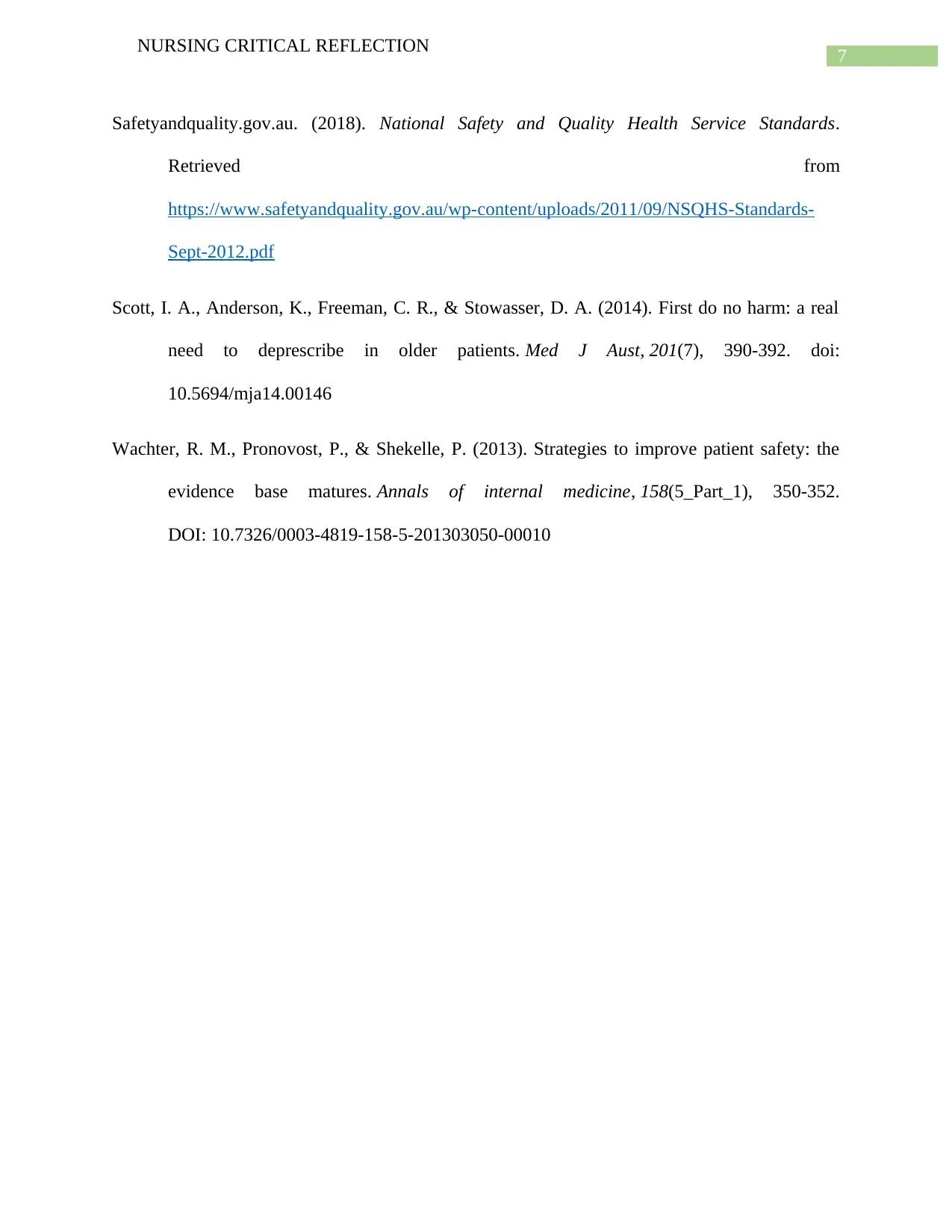
7
NURSING CRITICAL REFLECTION
Safetyandquality.gov.au. (2018). National Safety and Quality Health Service Standards.
Retrieved from
https://www.safetyandquality.gov.au/wp-content/uploads/2011/09/NSQHS-Standards-
Sept-2012.pdf
Scott, I. A., Anderson, K., Freeman, C. R., & Stowasser, D. A. (2014). First do no harm: a real
need to deprescribe in older patients. Med J Aust, 201(7), 390-392. doi:
10.5694/mja14.00146
Wachter, R. M., Pronovost, P., & Shekelle, P. (2013). Strategies to improve patient safety: the
evidence base matures. Annals of internal medicine, 158(5_Part_1), 350-352.
DOI: 10.7326/0003-4819-158-5-201303050-00010
NURSING CRITICAL REFLECTION
Safetyandquality.gov.au. (2018). National Safety and Quality Health Service Standards.
Retrieved from
https://www.safetyandquality.gov.au/wp-content/uploads/2011/09/NSQHS-Standards-
Sept-2012.pdf
Scott, I. A., Anderson, K., Freeman, C. R., & Stowasser, D. A. (2014). First do no harm: a real
need to deprescribe in older patients. Med J Aust, 201(7), 390-392. doi:
10.5694/mja14.00146
Wachter, R. M., Pronovost, P., & Shekelle, P. (2013). Strategies to improve patient safety: the
evidence base matures. Annals of internal medicine, 158(5_Part_1), 350-352.
DOI: 10.7326/0003-4819-158-5-201303050-00010
1 out of 7
Related Documents
Your All-in-One AI-Powered Toolkit for Academic Success.
+13062052269
info@desklib.com
Available 24*7 on WhatsApp / Email
![[object Object]](/_next/static/media/star-bottom.7253800d.svg)
Unlock your academic potential
Copyright © 2020–2025 A2Z Services. All Rights Reserved. Developed and managed by ZUCOL.





